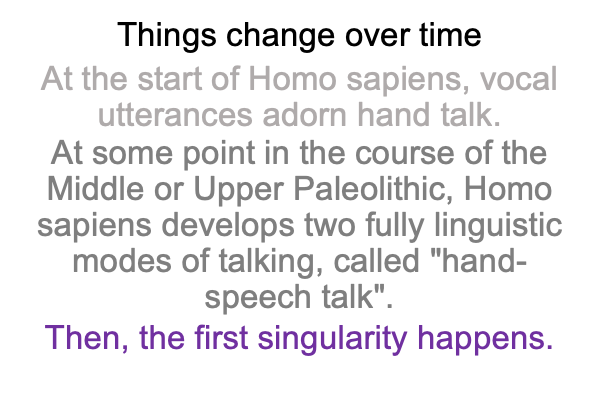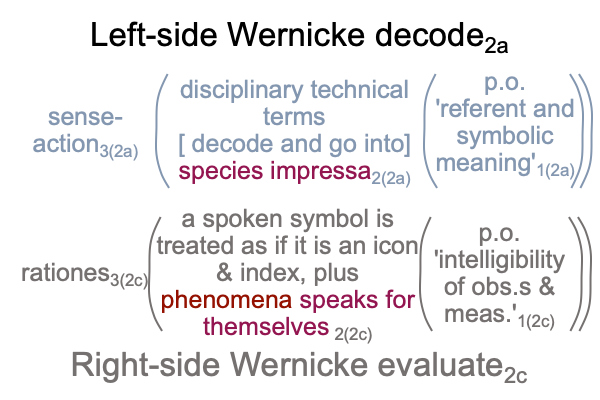0478 What happens after the hand-component of hand-speech talk dies?

0479 After the first singularity, traditions that relied on hand-talk are lost or are modified to work with speech-alone talk.
Of course, the modification business cannot stand, because hand-talk facilitates implicit abstraction and speech-alone can only pretend to facilitate implicit abstraction.
0480 Pretend?
Since speech-alone talk does not picture or point its referents, the spoken word precedes its referent. But, since language evolves in the milieu of hand-talk, we innately expect the referent to precede the word, rather than the other way around.
Speech-alone talk gives the impression that it images and indicates referents because word-referent associations exist before each individual is born, whether they are sensible or social constructions. In doing so, spoken words fulfill our evolved expectations. We expect the referent to precede the word, rather than the other way around.
0481 Steven Mithen devotes an entire chapter in The Language Puzzle to the issue of finding and learning the meanings of spoken words in our current Lebenswelt.
Guess how infants figure out spoken words.
They already know that words exist. It is only a matter of figuring out what they are.
Infants recognize one spoken word from another by tracking transition possibilities.
They do so before they start to talk.
0482 How much easier their lives would be if they grew up in a hand-speech talk tradition?
Hmmm, maybe, I should say, “How much more intuitively natural their mental processing would be, if…”
0484 Perhaps, this is one of the reasons why many current psychologists see no need to entertain the four interweaving hypotheses proposed by Julian Jaynes in 1976. They are focused on investigating the nature of language using sophisticated observations and measurements. They cannot see how their investigations comport with Jaynes’s formulation of the bicameral mind. The scientists are doing precisely what the voices in their heads are telling them to do.
I know that sounds goofy.
But, introspection does not seem to be a strong suite when it comes to modern bigilib academic “scientific” disciplines.
0485 Consider modern science in light of the following interaction between Wernicke’s regions, right and left, as delineated through Jaynes’s paradigm.

0486 Commitment2c resides in Wernicke’s region on the right. A positivist intellect3(2c) (rationes3(2c)) brings the actuality of disciplinary language2(2a) into relation with the possibility of observations and measurements1(2c). Disciplinary language2(2a) is treated as if its symbolic terms are icons and indexes of {real things [substantiating] phenomena}2(2c). In the process, Wernicke’s region on the right weighs what is2(2c) on the basis of universality. The scientist implicitly abstracts a species impressa2(2a) where phenomena speak for themselves2(2c)…
…in the language of the scientist’s discipline2(2a).
In other words, observations and measurements1(2c) will be situated as intelligible perceptions2b when they become… um… data for models2b.
0487 Can I say that another way?
Phenomena speak for themselves2(2c) through mathematical and mechanical symbols2(2c) in the normal context of a positivist intellect2(2c) operating on the potential of ‘intelligible observations and measurements1(2c).
0488 That is the SVi. What is the SOi?
Disciplinary technical terms [decode and go into] a scientific species impressa2(2a) in the normal context of positivist sensation3(2a) (portrayed here as the juxtaposition of “sense” and “action”) operating on the potential of ‘a scientific referent and its symbolic representation’1(2a).
0489 Why turn sensation2a into “sense” and “action” for scientific inquiry as what is happening3a?
Well, that is my impression2(2a) of phenomena speaking for themselves2(2c).
